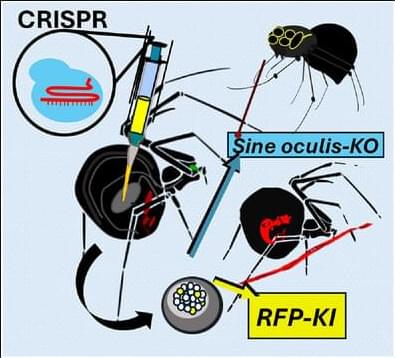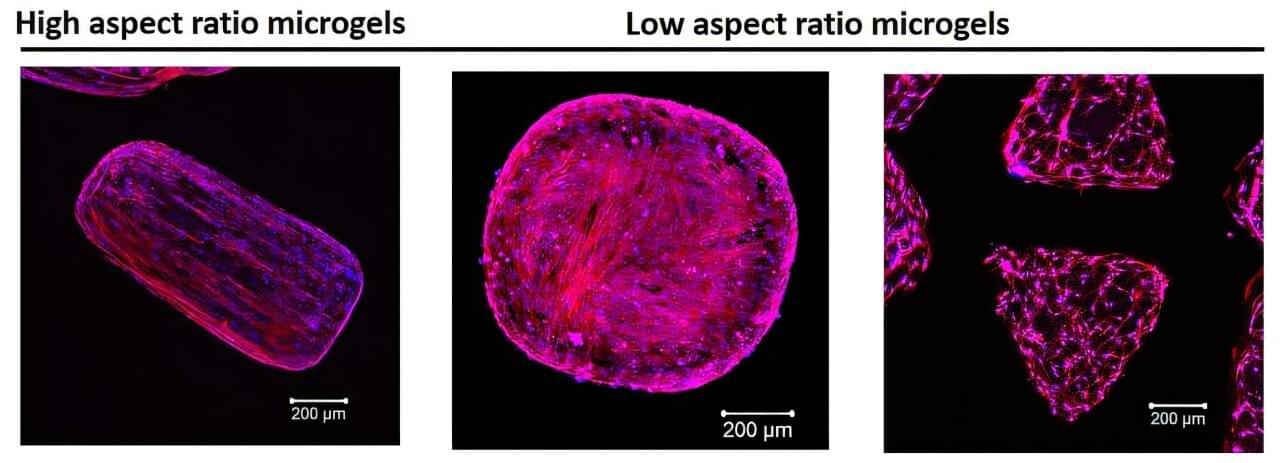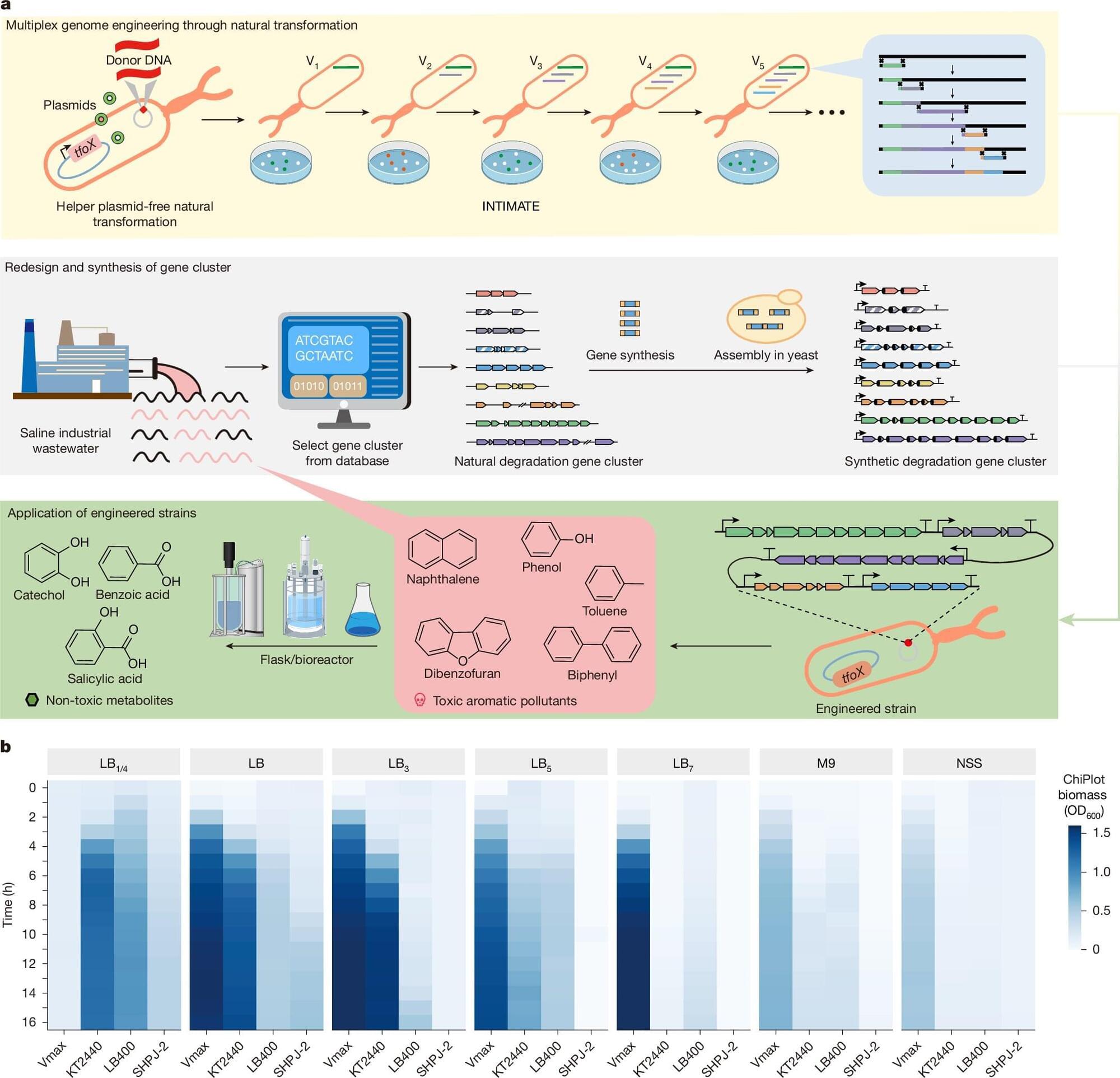Spiders exhibit unique traits with significant implications for a diversity of fields, and gene editing provides new opportunities for advancing research in these areas. In this study, we developed a…



Ribonucleic acid, also called RNA, is a molecule present in all living cells. It plays a critical role in transmitting genetic instructions from DNA and creating proteins. With the power to execute a plethora of functions, the little RNA “messenger” has led to important innovations across therapeutics, diagnostics, and vaccines, and made us rethink our understanding of life itself.
A team of researchers from Boston University’s Biological Design Center and the Department of Biomedical Engineering recently made significant steps forward in the development of the next generation of computational RNA tools. They recently published a study in Nature Communications describing a generative AI technique for designing different types of RNA molecules with improved function.
Much like a large language model that can be used to compose entirely new texts, the model can compose new RNA sequences tailored for specific tasks in the cell or in a diagnostic assay. Their research has shown that it’s possible to predict and generate RNA sequences that have specific functions across a broad array of potential applications.

Researchers at the Terasaki Institute for Biomedical Innovation (TIBI) have developed a technique that could help advance treatments in tissue engineering. The study, published in the journal Small, introduces a technique for producing tissues with precise cellular organization designed to mimic the natural structure of human tissue.
Using a simple light-based 3D printing method, the team created microgels with controlled internal architectures. These structures help guide how cells behave and grow, mimicking the way cells naturally behave in the body.
By adjusting properties of light as it interacts with hydrogels, the team modified the internal structure of these microgels, enabling precise control of cell organization in 3D space. This breakthrough addresses a major challenge in creating realistic, functional tissue environments critical for tissue repair and regeneration.
ITrust Capital: Use code IMPACTGO when you sign up and fund your account to get a $100 bonus at https://impacttheory.co/iTrustCapitalMay.
Shopify: Sign up for your one-dollar-per-month trial period at https://impacttheory.co/ShopifyApr.
On this mind-bending episode of Impact Theory, Tom Bilyeu sits down with Ben Lamm, the visionary entrepreneur behind Colossal Biosciences, to explore a world that sounds straight out of science fiction—yet is rapidly becoming our reality. Together, they pull back the curtain on the groundbreaking technology making de-extinction not only possible, but increasingly practical, from resurrecting woolly mammoths and dire wolves to saving endangered species and unraveling the secrets of longevity.
Ben explains how CRISPR gene editing has unlocked the power to make precise DNA changes—editing multiple genes simultaneously, synthesizing entirely new genetic blocks, and pushing the limits of what’s possible in biology and conservation. The conversation dives deep into the technical hurdles, ethical questions, and the unexpected magic of re-engineering life itself, whether it’s creating hairier, “woolly” mice or tackling the colossal challenge of artificial wombs and universal eggs.
But this episode goes way beyond Jurassic Park fantasies. Tom and Ben debate the future of human health, gene selection through IVF, the specter of eugenics, global competition in biotechnology, and how AI will soon supercharge the pace of biological engineering. They even touch on revolutionary solutions to our plastic crisis and what it means to inspire the next generation of scientists.
Get ready to have your mind expanded. This is not just a podcast about bringing back extinct creatures—it’s a deep dive into the next frontiers of life on Earth, the technologies changing everything, and the choices we’ll face as architects of our own biology. Let’s get legendary.
00:00 Meet Ben Lamm.

A multi-institutional collaboration of synthetic biology research centers in China has developed a genetically engineered strain of Vibrio natriegens capable of bioremediating complex organic pollutants, including biphenyl, phenol, naphthalene, dibenzofuran, and toluene, in saline wastewater and soils.
Complex organic pollutants are prevalent in industrial wastewater generated by petroleum refining and chlor-alkali processing. Due to their chemical stability and resistance to natural degradation, these compounds persist in marine and saline environments, posing ecological risks and potential threats to public health.
Microbial bioremediation methods typically use consortia of wild-type bacterial strains, yet these organisms demonstrate limited capacity to degrade complex pollutant mixtures. Elevated salinity levels further inhibit bacterial activity, diminishing bioremediation efficacy in industrial and marine wastewater. Developing bacterial strains capable of degrading pollutants while tolerating saline conditions remains a critical challenge.
Michael Levin is a scientist at Tufts University; his lab studies anatomical and behavioral decision-making at multiple scales of biological, artificial, and hybrid systems. He works at the intersection of developmental biology, artificial life, bioengineering, synthetic morphology, and cognitive science. Respective papers are linked below.
Round 1 Interview | What are Cognitive Light Cones? • What are Cognitive Light Cones? (Mich…
Round 2 Interview | Agency, Attractors, & Observer-Dependent Computation in Biology & Beyond • Agency, Attractors, & Observer-Depend…
Bioelectric Networks: The cognitive glue enabling evolutionary scaling from physiology to mind https://link.springer.com/article/10…
Darwin’s Agential Materials: Evolutionary implications of multiscale competency in developmental biology https://link.springer.com/article/10…
Biology, Buddhism, and AI: Care as the Driver of Intelligence https://www.mdpi.com/1099-4300/24/5/710
Bioelectric Networks as \.
We discuss Michael Levin’s paper “Self-Improvising Memory: A Perspective on Memories as Agential, Dynamically Reinterpreting Cognitive Glue.” Levin is a scientist at Tufts University, his lab studies anatomical and behavioral decision-making across biological, artificial, and hybrid systems. His work spans developmental biology, artificial life, bioengineering, synthetic morphology, and cognitive science. 🎥 Next, watch my first interview with Michael Levin… What are Cognitive Light Cones? • What are Cognitive Light Cones? (Mich… ❶ Memories as Agents 0:00 Introduction 1:40 2024 Highlights from Levin Lab 3:20 Stress sharing paper summary 6:15 Paradox of change: Species persist don’t evolve 7:20 Bow-tie architectures 10:00 🔥 Memories as messages from your past self 12:50 Polycomputing 16:45 Confabulation 17:55 What evidence supports the idea that memories are agential? 22:00 Thought experiment: Entities from earth’s core ❷ Information Patterns 31:30 Memory is not a filing cabinet 32:30 Are information patterns agential? 35:00 🔥 Caterpillar/butterfly… sea slug memory transfer 37:40 Bow-tie architectures are EVERYWHERE 43:20 Bottlenecks “scary” for information ❸ Connections & Implications 45:30 🔥 Black holes/white holes as bow-ties (Lee Smolin) 47:20 What is confabulation? AI hallucinations 52:30 Gregg Henriques & self-justifying apes… all good agents storytellers 54:20 Information telling stories… Joseph Campbell’s journey for a single cell 1:00:50 What comes next? 🚾 Works Cited 🚩 Self-Improvising Memory: A Perspective on Memories as Agential, Dynamically Reinterpreting Cognitive Glue https://www.mdpi.com/1099-4300/26/6/481 https://thoughtforms.life/suti-the-se… our way to health with robot cells | Michael Levin (Big Think 2023)
• Biohacking our way to health with rob… https://peregrinecr.com/ 🚀 What is this channel? Exploring Truth in philosophy, science, & art. We’ll uncover concepts from psychology, mythology, spirituality, literature, media, and more. If you like Lex Fridman or Curt Jaimungal, you’ll love this educational channel. p.s. Please subscribe! Young channel here. =) #science #memory #biology #computing #mind #intelligence #attractor #polycomputing #bioelectric #cybernetics #research #life
At the Artificiality Summit 2024, Michael Levin, distinguished professor of biology at Tufts University and associate at Harvard’s Wyss Institute, gave a lecture about the emerging field of diverse intelligence and his frameworks for recognizing and communicating with the unconventional intelligence of cells, tissues, and biological robots. This work has led to new approaches to regenerative medicine, cancer, and bioengineering, but also to new ways to understand evolution and embodied minds. He sketched out a space of possibilities—freedom of embodiment—which facilitates imagining a hopeful future of \.
Recorded 6 November 2024. Michael Levin of Tufts University presents “Non-neural intelligence: biological architectures for problem-solving in diverse spaces” at IPAM’s Naturalistic Approaches to Artificial Intelligence Workshop. Abstract: The familiar, readily-recognized intelligence of brainy animals has long served as inspiration for AI. However, biological intelligence is far older than neurons, and indeed than multicellularity. My lab studies problem-solving in cells, tissues, and even subcellular components, operating in different spaces and at different scales than conventional intelligent agents. In this talk, I will describe a framework for detecting, communicating with, and creating collective intelligences, and show examples of how the fundamental properties of life suggest novel approaches for ethically relating to diverse and fascinating engineered and hybrid intelligences. Learn more online at: https://www.ipam.ucla.edu/programs/wo…
In this episode, Dr. Michael Levin, Distinguished Professor of Biology at Tufts University, joins Nathan to discuss embodied minds, his research into limb regeneration and collective intelligence, cognitive light cones, and much more. Dr. Levin and the Levin Lab work at the intersection of biology, artificial life, bioengineering, synthetic morphology, and cognitive science.
LINKS:
The Levin Lab and Dr. Michael Levin’s research: https://drmichaellevin.org/resources/
Dr Michael Levin’s blog: https://thoughtforms.life/about/
Tufts University Faculty Profile: https://as.tufts.edu/biology/people/f… Levin @ Wyss Institute: https://wyss.harvard.edu/team/associa… Dr. Levin’s Research on Limb Regeneration: https://news.uchicago.edu/how-bioelec… SPONSORS: The Brave search API can be used to assemble a data set to train your AI models and help with retrieval augmentation at the time of inference. All while remaining affordable with developer first pricing, integrating the Brave search API into your workflow translates to more ethical data sourcing and more human representative data sets. Try the Brave search API for free for up to 2000 queries per month at https://brave.com/api Omneky is an omnichannel creative generation platform that lets you launch hundreds of thousands of ad iterations that actually work customized across all platforms, with a click of a button. Omneky combines generative AI and real-time advertising data. Mention “Cog Rev” for 10% off www.omneky.com NetSuite has 25 years of providing financial software for all your business needs. More than 36,000 businesses have already upgraded to NetSuite by Oracle, gaining visibility and control over their financials, inventory, HR, eCommerce, and more. If you’re looking for an ERP platform ✅ head to NetSuite: http://netsuite.com/cognitive and download your own customized KPI checklist. X/SOCIAL @labenz (Nathan)@drmichaellevin (Michael) @CogRev_Podcast TIMESTAMPS: (00:00) Preview (01:07) Intro and brief summary (05:40) Xenobots, anthrobots and the other creatures created by Mike Levin (09:39) Bioelectric memory rewriting (15:01) Sponsor | BraveSearch API (16:09) The difficulty of conducting simulations, which involve running forward passes to predict and alter electrical patterns (20:30) The concept of backpropagation and mode switching in AI models (23:06) Why humans do not regenerate their limbs (37:10) Sponsor | Netsuite (39:40) Learning from small and biological systems onto the concept of possible emergence (45:16) The criticality of multiple scale questions and would a single scale? (55:49) The concept of the cognitive light cone (59:43) Advice on habits of mind and suggestions for inspiration on the AI side (1:13:36) Mike’s suggested directions for the AI developers (1:24:49) Wrap & Sponsor | Omneky The Cognitive Revolution is produced by Turpentine: a media network covering technology, business, and culture. Producer: Vivian Meng Editor: Graham Bessellieu For sponsor or guest inquiries, email: [email protected] Music licenses: ABZUSWHJII08TSRH 376I29BQPJASOLX2
Michael Levin @ Wyss Institute: https://wyss.harvard.edu/team/associa…
Dr. Levin’s Research on Limb Regeneration: https://news.uchicago.edu/how-bioelec…
SPONSORS:
The Brave search API can be used to assemble a data set to train your AI models and help with retrieval augmentation at the time of inference. All while remaining affordable with developer first pricing, integrating the Brave search API into your workflow translates to more ethical data sourcing and more human representative data sets. Try the Brave search API for free for up to 2000 queries per month at https://brave.com/api.
Omneky is an omnichannel creative generation platform that lets you launch hundreds of thousands of ad iterations that actually work customized across all platforms, with a click of a button. Omneky combines generative AI and real-time advertising data. Mention \.